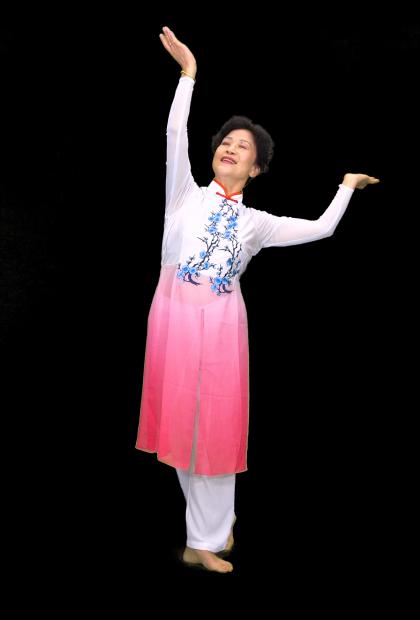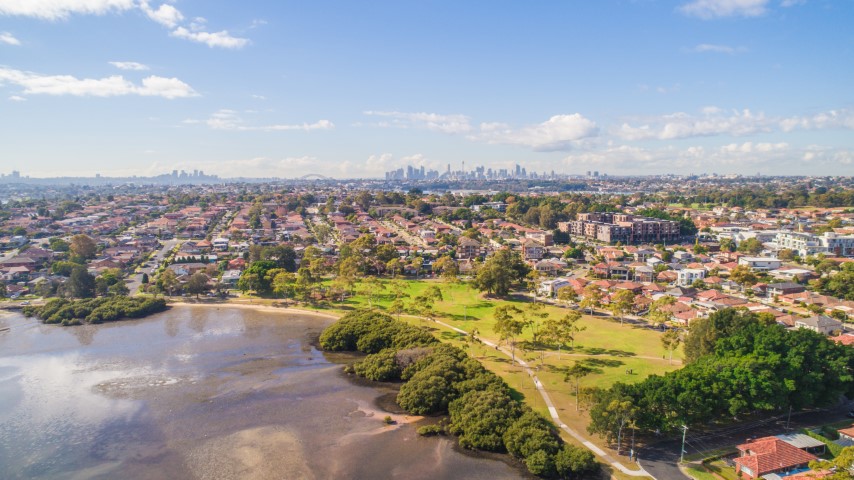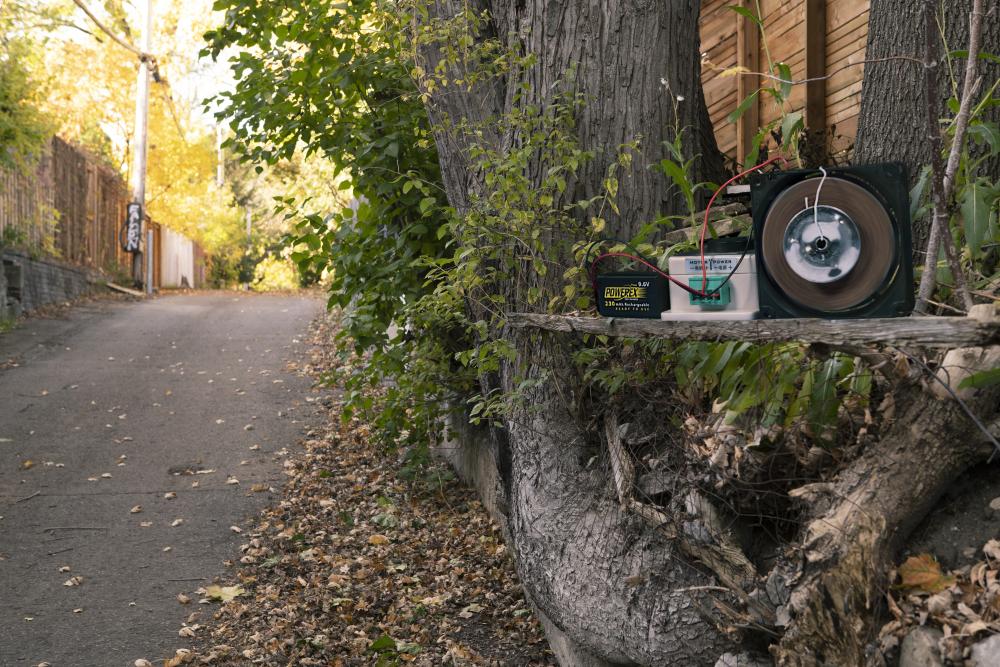The Digital Gallery
Located in the foyer of The Learning Space, The Digital Gallery is an exhibition space for video, interactive and digital art.
The Digital Gallery Exhibition: Mangrove Magic
23 April to 13 May 2024
‘In 2018, while I lived in Sydney, in partnership with Art Spark Studio, I led an ink painting workshop titled “Protect Our Mangrove” with the City of Canada Bay. Before the art workshop, an expert showed the participants and me around the mangrove in Kokoda Park. With a root sample and a bit of water, she demonstrated how the mangrove’s root works like a snorkel. The ingenuity of nature struck me.
Digitally edited drawings of native flora and videos of the shore of the Paramatta River are integrated into this short film. The exploratory and thoughtful approach of this work explores ways to integrate animation and visual storytelling for the public space.
As a Culturally and Linguistically Diverse Artist, my concern is for my art to be accessible to a wide audience. My signature limited colour palette, the slow unravelling of the images, and the meditative music of my short film aims at engaging the local community, children and adults alike, while using the foyer of The Learning Space. I hope while watching this video that you will be inspired by the beauty of the mangrove you live so close to. May you be inspired to connect with it and look after it.
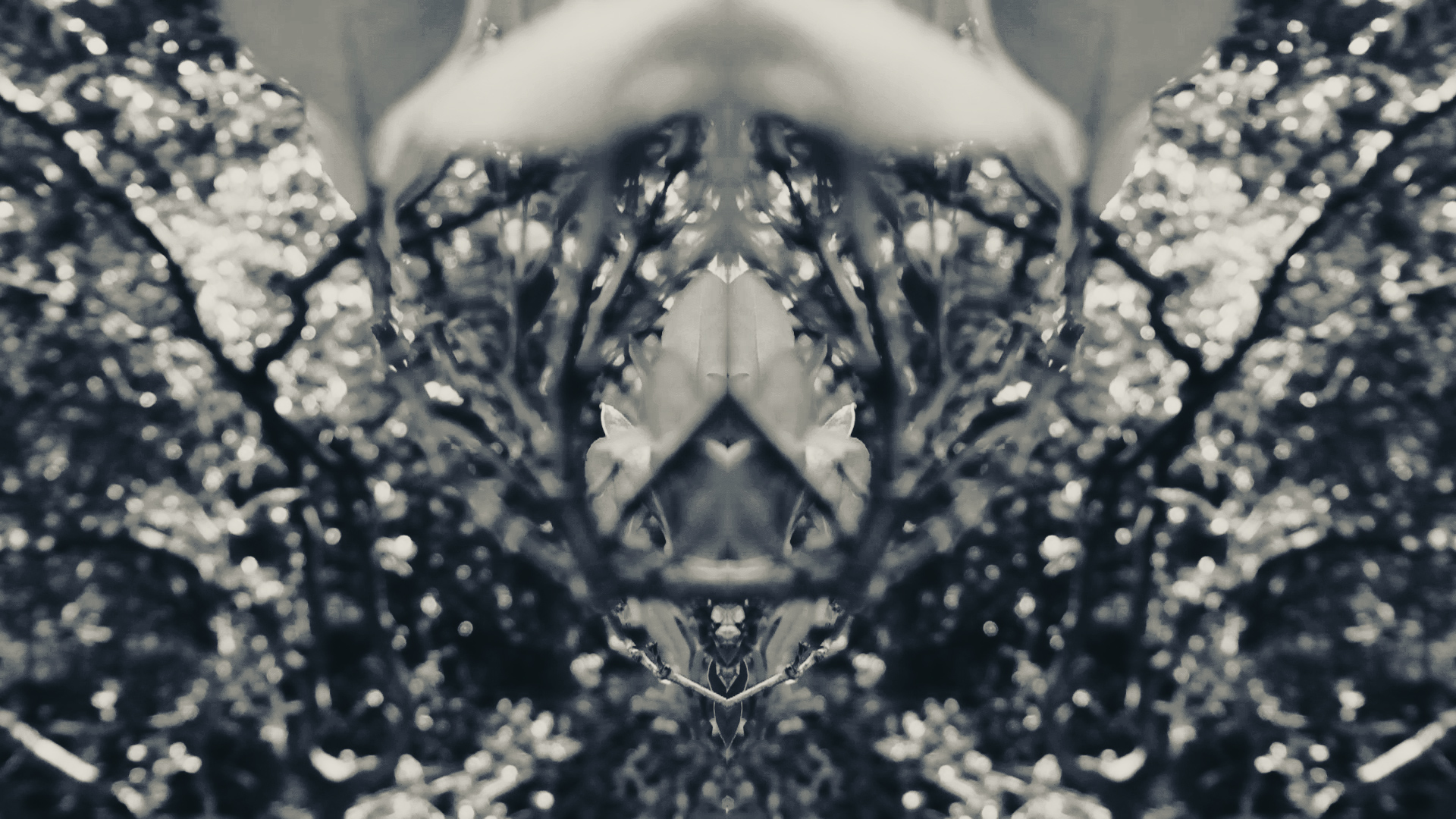
Previous exhibitions:
The Sky is Falling
25 March – 17 April 2024
‘The Sky is Falling’ is an exploration of superstitions as manifestations of anxiety. In absurd animations, feelings of avoidance, obsession and catharsis are depicted through distressed cartoons. Each frame is hand painted, creating visceral textures which exaggerate the extreme language of cartoons, with its rubber limbs and immortal characters.
In these stop motion animations, figures are shown being ridiculously and messily deconstructed by a cycle of spiralling emotions. Trapped in a loop of their own making, each doomed character highlights the futility of attempting to ward off one’s own emotions.
This exhibition presents a personal exploration of the subject of anxiety and the questions and responses it evokes. Rather than shying away from negative emotions and increasing one's dread, ‘The Sky is Falling’ explores the way accepting fear and embracing failure can be an antidote to anxiety.
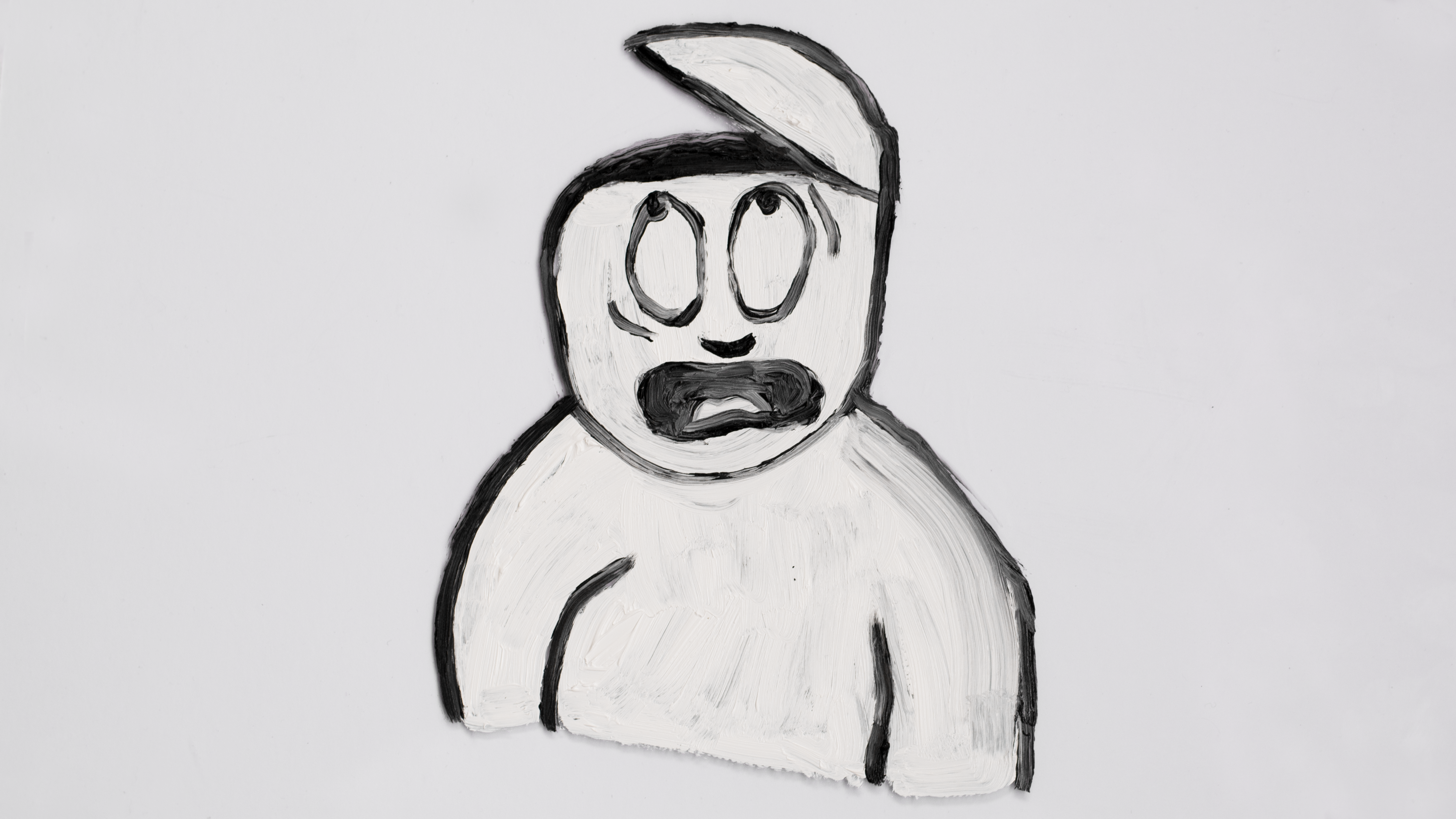
artificial field recording
Elizabeth Millar
27 February – 18 March 2024
artificial field recording by Elizabeth Millar comprises a series of kinetic sculptures that sound in amongst the urban spaces and pathways of the Montreal neighbourhood where Millar resided between 2020 and 2022.
The sound sculptures are assemblages of repurposed materials, such as cardboard, wood, metal and felt, which are activated by small computer ventilation fans. They were recorded in studio and composited into the urban environments using chroma keying (green screen). Some of the sculptural materials are displayed in the gallery alongside the audio-visual work. This exhibition asks us to consider our awareness of place and belonging in our day-to-day lives.
Team Spirit
Claire Healy & Sean Cordeiro
30 January – 19 February 2024
Team Spirit is a playful study on scales of community engagement. Filmed in Shirone, Japan, the visuals focus on the annual Giant Kite Battle that takes place along the Nakanoguchi river bank. The kite festival has been taking place for over 300 years on the West coast of central Honshu. Local teams take a year to create the kites, battled against other neighbourhood teams in a week-long battle in a remarkable mix of community spirit, chaos and fun.
The project is narrated in Esperanto, the most widely-spoken constructed international auxiliary language. It is a language filled with global Utopian ideals of peace and understanding between nations. The grand ideals of Esperanto are juxtaposed with the highly localised subject of narration.
The narration is an account of a volunteer's participation in a Sausage Sizzle. To Australians, a Sausage Sizzle is more than cooking meat. It conjures images of democracy and is quintessentially Australian.
To explain the place that Sausage Sizzle holds in the Australian psyche is like trying to explain the significance of a Tea Ceremony. Anyone can drink a cup of tea, or fry a sausage, but these simple acts take on larger significance. The clash of the Kite Battle with the quotidian Sausage Sizzle represent two contrasting types of local activity, nestled within the community-minded Esperanto.
This two-channel video is subtitled in English and Japanese.
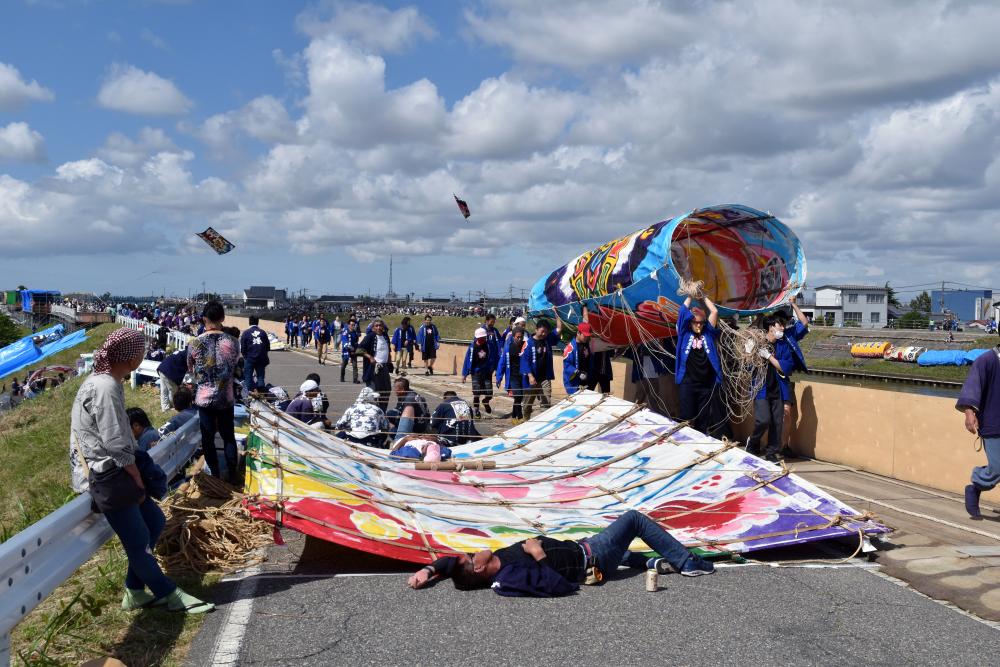
Of the Muted Flowers
Sharoud Ghahani
10 October – 7 November 2023
Of the Muted Flowers is a visual, emotional, and sensory compilation of images and text, which reflects on identity, cultural memory, and the artist’s fragmentary connection to an imaginary homeland.
While this work is personal, it invites the viewer to engage with symbols and ideas related to themes of cultural isolation and alienation that can be felt collectively by diasporic communities across the world.
In the confusion and chaos of words lost in translation, the silence of flowers is symbolic – it can provide solace when all the other ways of communication are closed. One can find comfort by recognising and contemplating species of flowers from faraway lands.
The hazy artworks in the series aim to convey the sense of weightlessness and the experience of tumbling into the unknown, whereas the surrealist artworks are allegorical and are destined for the viewer’s interpretation. Images from the artist’s personal archive are juxtaposed with colour studies and poetry in different languages.
Shahroud Ghahani is an Iranian-Australian interdisciplinary artist based on Gadigal land. Her artworks bridge together rich images from disparate cultures and her experiences of them.
She holds a Master of Art from the University of New South Wales, Art, Design and Architecture and has had her work exhibited in galleries across Sydney.
Her practice explores representations of female archetypes and themes of beauty, the grotesque, and identity within Eastern and Western traditions.
Her art is also inspired by explorations of metaphysical subjects. She interweaves dreamscapes, liminal and imaginary spaces, displaced objects, and allegorical imagery.
She is currently a resident artist at the Primrose Park Art Studio a program managed by North Sydney Council.
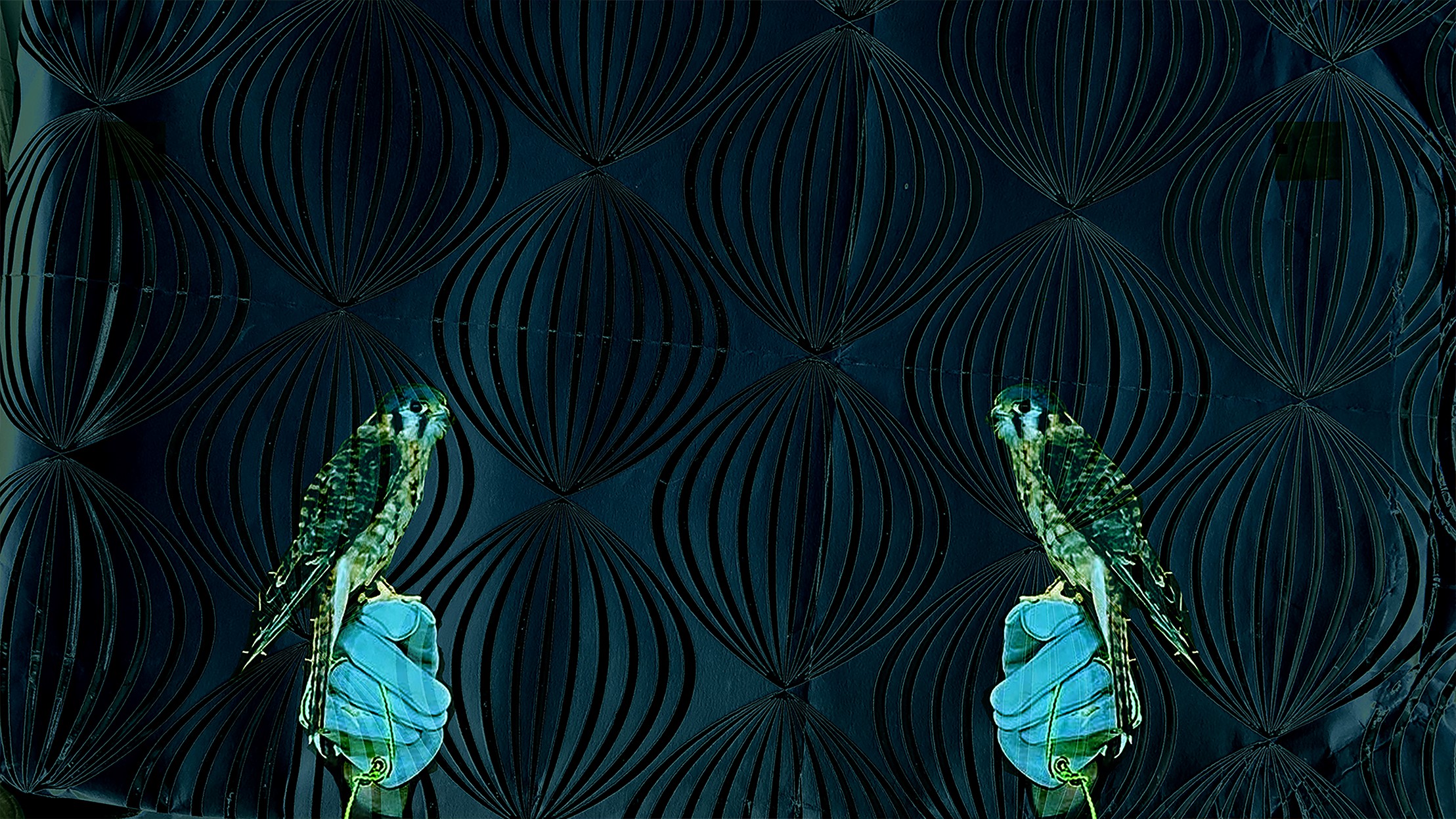
Infinity
Si Yi Shen
4 September – 2 October 2023
The Digital Gallery is proud to present Infinity by Si Yi Shen from 4 September to 2 October 2023.
Infinity is a digital mural exploring symbolism and landscape as an interrogation of the artist’s diasporic experience and belonging. By juxtaposing Chinese scroll painting composition and the Australian landscape, this work creates intimate spaces that provoke an emotional response from the audience.
Infinity experiments with story telling methods describing the community, people and place using non-verbal 🙊, ubiquitous 🤲 and semantic 🌸strategies. Underpinning this is Shen’s technique of remixing, collaging and kitbashing digital material (photographs, videos, archives, colours and emoji) into syntax.
This process has sent the artist deep-diving into experimentation with ‘digital memorabilia’ (the myriads of fragments forming the reminiscence of a place, event or communication, documented via electronic means).
Such fragments include images, videos, memes, gifs, emojis, audio and 3D scans. Digital memorabilia takes the narrator's role in Infinity, weaving stories of experience from both the artist and that of others.
Si Yi Shen is an emerging artist working across digital collage and 2D animation, projections, installations and emerging technologies, including augmented reality (AR). Their current art practice explores personal and collective interaction and communication in the digital age. Recent projects include EDGE: Sydenham 2044 x Auspicious Beasts (2023), Migrating West - Open Cut Commissions Broken Hill Gallery (2023), Thrive - The Digital Gallery (2022), Sending You Love - Casula Powerhouse Arts Centre, City of Liverpool (2021), Living - Storybox Darling Harbour / Parramatta, ESEM Projects (2021). She was a recent finalist of the Ravenswood Australian Women's Art Prize (2023) and a participating lab artist at Platform Art (2023).

..... It's full of stars!
Trevor Oates
7–27 August 2023
The Learning Space is proud to present the exhibition ..... It's full of stars! by Trevor Oates in The Digital Gallery.
Trevor Oates has created a collection of images using ancient light captured through his telescope and astronomic camera. The images display a range of gas clouds in our own galaxy, just a few thousand light years away, to whole galaxies of stars tens of millions of light years away.
Light years, a measure of distance used by astronomers, signify the distance travelled by a beam of light in one year. Given that light travels at 300,000 km per second, it's an immense distance. Since the light takes so long to reach Earth and Trevor's Telescope, these images represent the subject as it would have been many years ago.
Capturing images of distant objects in the night can be an uncomfortable, often frustrating, but ultimately rewarding hobby for Trevor. Once the light, as photons, is converted into electrons by his camera and captured by his microcomputer, Trevor post-processes the data using special software to create the images seen. Image processing involves both art and science, but it's all based on the data, so it isn't just a work of imagination.
Trevor Oates has been a Program Officer at The Learning Space for the past five years. Astronomy has been a long-held interest of his, evolving into a hobby over ten years ago when he captured the transit of Venus across the Sun's surface. His initial setup included a bird-spotting telescope with a solar filter, a tripod, a pocket digital camera for image capture, and a can of tomatoes strapped to the front of the telescope with a rubber band to balance the weight of the camera. From these humble beginnings, Trevor has honed his skills and transitioned to a far more sophisticated telescope setup, enabling him to gather images with greater depth and clarity.
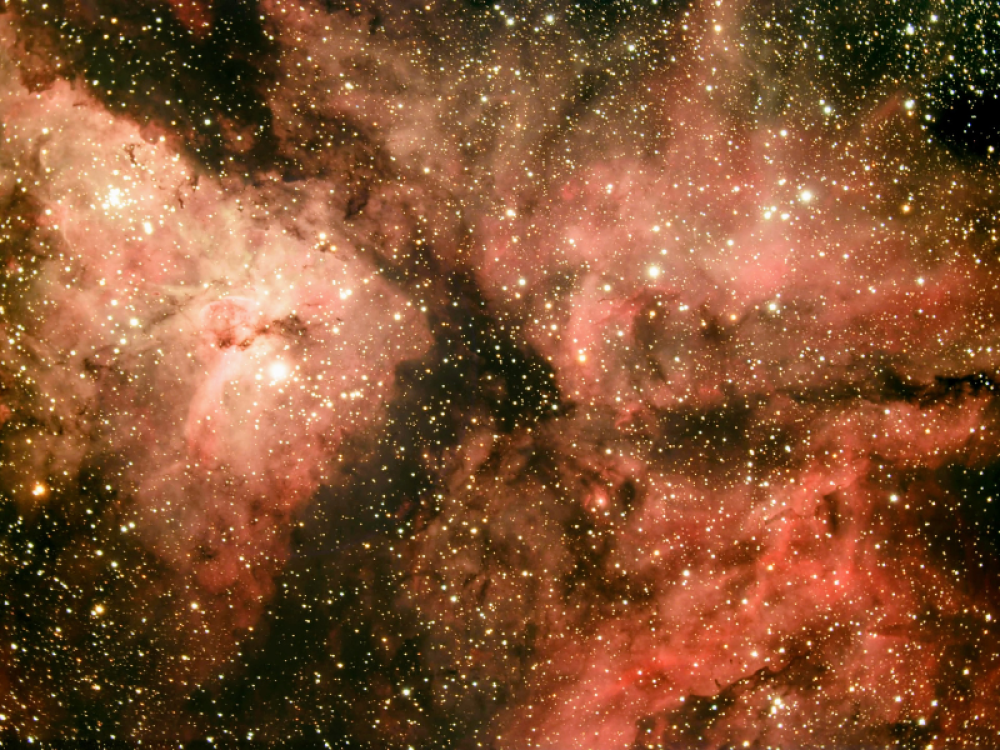
Indigitober
Melle Smith-Haimona
3 July — 1 August 2023
The Learning Space is proud to present the NAIDOC Week exhibition, Indigitober by Melle Smith-Haimona.
Indigitober was born in 2022 after Melle read an article about racism online within the manga, cosplay and anime communities. Melle was inspired by the international Inktober drawing challenge and decided to bring awareness of Blak excellence within these spaces.
The prompts in the Inktober challenge gave Indigenous artists the chance to create their own characters, redrawn in their styles and to flip entire concepts on their head.
The exhibition aims to give people the chance to see that Aboriginal art isn’t just one thing but can be as wildly diverse as any other sector of the art community with hidden nuggets of culture lovingly left throughout each piece.
Melle is a 32 year old mother of two and proud Ngunnawal woman living on Wangal Country. Melle’s artwork has a strong sense of feminine power and connection to her Country, as well as the Country she has been raised on here in Sydney. She uses her artwork as a physical representation of her journey home.
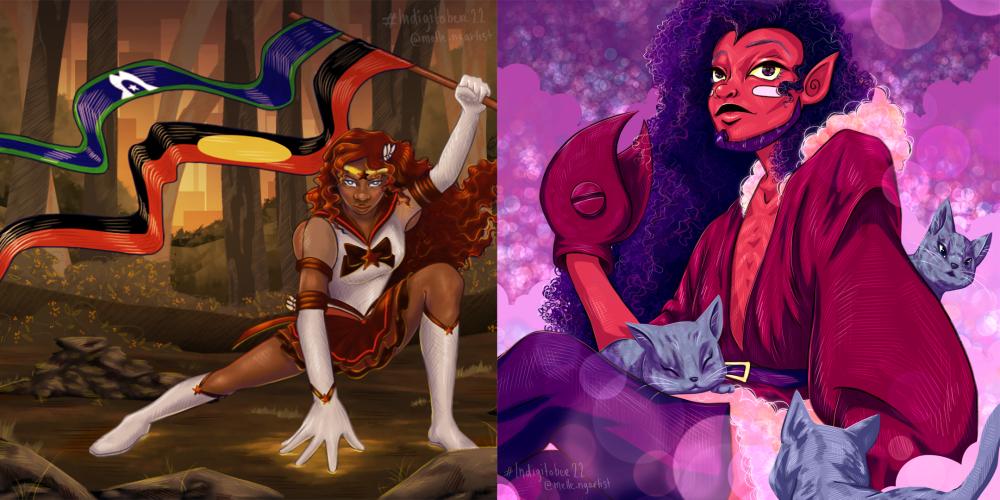
Generating Pixels
7–20 June 2023
The month of June is all about robots at The Learning Space, Rhodes. In keeping with this theme, The Digital Gallery will look at the creative possibilities of artificial intelligence by exploring the collaborative text to image (human to AI) interaction in an exhibition titled Generating Pixels.
Using language prompts, poetry and lyrics, this experiment explores the contrast between what individuals perceive in our mind's eye and contrasts it to the generated imagery from current AI platforms.

ENERGY RETICULATION
Sam James
8 May – 4 June 2023
In ENERGY RETICULATION, Sam James is interested in how energy comes from distant places and arrives at our doorstep and understanding more of the enormous power generation being sacrificed for our existence. James frequently makes light drawings as an expression of space and place, which take the form of lines drawing themselves out over background imagery of sites. With these ‘reticulation’ paths James made for Rhodes, he used copper wire to trace the maps of NSW regional, macro and micro urban electrical grids leading over hundreds of kilometers into The Connection at Rhodes.
The construction of solar and wind farms in regional NSW is still in transition so energy production in NSW is still a surprising 85%-15% Fossil Fuel to Renewable ratio in 2023.
This animated video shows power loads increasing, decreasing and being distributed over the renewed environment in Canada Bay, from a past previously polluted waterway to an urban environment focused on sustainability.
The Connection in Rhodes itself is powered by 99KW of Solar panels.
Samuel James is a filmmaker and projection designer living on Gundungarra and Dharug land, Blue Mountains. He has collaborated as a video artist on more than 250 works with contemporary performance companies since 1994. His projection work is often seen in Australian Festivals, being born from developments with independent dancers and experimental companies. He has worked internationally in Europe, Canada and South Korea and regularly participates in international residencies (Norway, Czech Republic, Iceland, Finland, The Banff Centre, Calcutta, Berlin). He has an expanding animated archive and develops and presents this work mapped onto theatrical, urban and natural spaces. He completed an MFA on Digital Animism. In his video drawings the act of mark making superimposed in virtual space is an unconscious response to spirit of place.

Dark Matter
Dustin J Voggenreiter
11 April – 7 May 2023
The Dark Matter is a series of digitally animated GIFs, daisy-chained together into an endlessly looping work of art. The project harnesses the ancient symbolic omen of shooting stars, framed (literally) within the evolving theories of perception proposed by contemporary cognitive psychologists. These two ideas (ancestral symbolism and the evolution of human perception) continue to confuse, seduce and inform Dustin's practice.
Large swathes of this work are absorbed by darkness - poetically eluding to the gaps in our species ability to grasp reality. This is an idea which extends from Plato’s famous cave shadow allegory (500+ BCE) to avant-garde theories proposed by Cognitive Psychologist Dr Donald Hoffman, all of which highlight the inadequacy of human perception. We are, in essence, trapped.
It is Dustin's conjecture as an artist that we can only ever begin to resolve the plethora of issues presenting us as a species, once we understand and accept the biases, blind spots, and unresolved design ‘flaws’ which evolution has endowed us with. We peer through a narrow perceptual window at reality.
The Dark Matter utilises the monotony inherent in the GIF format as a means of channelling the looping, unresolved nature of these ideas. Like a scratched record stuck in its groove, it seems as though humans too will be forever trapped within our species specific experience of reality.
Dustin J Voggenreiter is an Australian artist whose work communes with ancestral spirits, sharing a deep empathy for the human condition. His practice spans contemporary abstraction and installation, with an aesthetic bent towards monochromatic minimalism.
Dustin’s work spans an eclectic material pallet which speaks to a post-covid aesthetic; using materials at-hand, recycling and reappropriating. Methods of concealment and obscuring serve to simplify the conceptual complexity of who we are as a species, habitually informed by the dramatic, tumultuous 21st century news cycle. His works are at once pleasurable explorations of texture, colour, and improvisation, as well as being a meditation on the invisible forces underlying human nature.
Dustin has recently graduated from the MFA program at RMIT, has started exhibiting at galleries around Melbourne, and has completed the SITUATE Residency during the first half of 2022.

In Rhodes
Helene Cochaud
6 March – 2 April 2023
“Photography is an art of observation. It has little to do with the things you see and everything to do with the way you see them.” Elliot Erwitt
In Rhodes' is a rhythmically playful and observational exploration of place. Each work begins with a single photograph taken in the Rhodes area. These images are then manipulated by playing with scale, rotation and repetition (a process of overlaying the image over itself). The resulting composite imagery produces a strangely familiar but unsettling reflection of the local environment whilst also allowing the audience to see Rhodes in a new perspective.
Helene Cochaud is a creative documentary photographer. In her work she documents the lives of ordinary people and environments. She is driven by curiosity and a need to scratch beneath the surface and discover new things. Her work has been collected by the State Library of NSW and Fairfield Museum & Gallery and been exhibited in both solo and group exhibitions over a number of years. Recently, she completed a large community-based project in Fairfield as the inaugural City Photographer and was shortlisted in the Documentary section in the Australian Photography Awards October 2022.
The artist would like to acknowledge the Wangal people of the Eora nation as the traditional custodians of the land on which this work was made.

Network
Wesley Dowling
23 January – 1 March 2023
Network is an interactive website that accumulates the dimensions of web browser windows that visit the site and transforms them into an endless scrolling feed. Through clicking or tapping on screen, site visitors can contribute to the artwork by creating window panels based on their web browser size. By tracking the size of each participant's web browser window, it generates a unique archive composed of the browsers who have visited and interacted with the site. As users scroll, their contributions transform into colourful window panels that merge to create an ever-changing visual landscape.
The artwork was developed during COVID-19 lockdown in recognition and response to doomscrolling - the act of addictively scrolling through endless news and social media feeds and consuming bad news regarding the pandemic. By seeking assurance to gain a sense of preparedness and control during times of uncertainty, doomscrolling sets up a feedback loop of continually drawing people back to the news and scrolling yet again. This transient assurance gained by reading the news worsens anxiety over time. Network explores the soothing compulsion of doomscrolling by perpetually enticing the viewer with the possibility of something new appearing in the feed. The movement and positions of the browser windows are constantly recycled and updated as the user scrolls, merging and overlaying with previous user interactions. This generates an endlessly changing stream of information, and unique artwork for each audience to observe.
Wesley Dowling is a Melbourne-based emerging queer artist whose work encompasses lens based and interactive digital media. He creates web-browser based works that examine and queers the normative structures that are embedded in digital imaging and computing.

WISH/DREAMS
Edison Chen
1 – 29 August 2022
WISH/DREAMS is an artwork that uses social media to create an atmosphere and space of renewed hope. Through Twitter, participants are invited to tweet their wishes and dreams, which will then be collected and displayed in a physical environment.
The artwork comes at a time where society is adjusting to the pandemic and individuals are finding their footing again. WISH/DREAMS provides an opportunity to share our hopes for the future, giving space and permission for people to dream. The artwork aims to give the Rhodes community an insight into each other’s wishes, encouraging a sense of connection, understanding and comradery, and to let people know that they are not alone.
Edison Chen is a Sydney-based new media artist, who works with a range of technology, including interactive sculptures, mixed reality, and artificial intelligence. His art projects explore the potential for technology to create connections through public play and interactivity. The style and outcome of his work is to promote empathy and altruism between strangers. His artworks have been shown at Vivid Sydney in 2016 and 2018.

To the Sun to the Moon and Back
Zorica Purlija
6 – 26 June 2022
From the Sun to the Moon and Back archives the discordant time of 2020, responding to the unprecedented social, environmental, and economic impacts of the COVID- 19 global pandemic. Photographing family, friends and strangers, artist Zorica Purlija explores the importance of relationships and care, with the resulting photographs capturing fractured moments of frivolity, homeschooling anxieties and fear as the pandemic continued to spread.
Zorica Purlija migrated from Montenegro to Australia in 1972 at the age of eight. She is currently based in Sydney. Her current practice has been focused on attachments, the psychology and space around our primary relationships and how it impacts our future self. Her art is informed by feminist values and hopes to tap into our universal longings for equality. Graduating in 1989 with an Associate Diploma in graphic design and photography at The University of Western Sydney, Zorica spent some years travelling through Europe, experiencing life and art. For the last twenty years she has been practicing as a fine art photographer while raising her family, and in July 2020 she completed her Masters of Art in photo media at the UNSW School of Art and Design.

Thrive (欣欣向荣)
Si Yi Shen
2 – 29 May 2022
Transitions from sparse to dense, pale to rich, Thrive (欣欣向荣) is a digital mural expressing the notion of affinity through growth and nurture. Through City of Canada Bay community participation and the artist's archive, this collection of pictures was meticulously photoshopped and animated, creating a dynamic network of interconnected flowers.
This work takes inspiration from the artist's mother's non-verbal communication with overseas family members and friends. She shares photographs of flowers as digital greetings. Thrive is part of a body of work that the artist developed for the past two years, utilising her pictures as the paint palette.
Si Yi Shen is an emerging multidisciplinary artist working with digital media, mixed reality (XR) technology and installation, moving between online and offline domains. Her current practice explores diaspora experience through the body of an immigrant in a digitally enabled world.
Recent commissions include In the Moment — Boronia Grove Community Centre, City of Parramatta (2021), Sending You Love — Casula Powerhouse Arts Centre, City of Liverpool (2021), Living — Storybox Darling Harbour / Parramatta, ESEM Projects (2021), The Eclipse — Willoughby Visual Art Biennial (2019) and The Bloom and the Moon — The Digital Gallery, Rhodes (2019). Shen was also a finalist in the Fisher's Ghost Art Prize (2021 and 2019) and Rookwood Hidden Sculpture Walk (2018).
Shen currently lives, works, and plays on Gadigal land, Sydney, Australia.

The Great Year and the Seventy-Two Seasons
Chris Caines
17 March – 14 April 2022
The Great Year and the Seventy-Two Seasons is a contemplative four-channel video artwork that contrasts the current 72-year median human lifespan with the precessional rotation of the Earth’s axis over 26,000 years. To put this in perspective, seventy-two years is the equivalent of one-degree of the Earth’s 360-degree rotation around the sun.
The Earth’s axial precession has been referenced in many ancient cultural traditions, including astronomical, astrological, scientific and religious practices. Chinese, Mayan, Indian, Khmer, Egyptian and ancient Greek civilizations mapped the motion of the Earth’s precession; Hipparchus of Rhodes in 120BC documented the measurement and Plato is thought to be among the first to refer to the cycle as “The Great Year”.
The Great Year and the Seventy-Two Seasons offers an opportunity to consider the context of deep time in relation to a single human lifespan – the chance to view the subjective concerns of our lives inside the cycles of the Earth and planets that we inhabit.
Chris Caines is an interdisciplinary artist who has worked internationally in a variety of digital and electronic media for over twenty years. This includes mediums such as video, radio, music and sound. His work has been collected by and seen at many festivals and museums including ACMI, the Queensland Art Gallery, he Museum of Modern Art, New York, Tate UK, the Art Gallery of NSW and the Berlin, Venice and Cannes festivals. The development of The Great Year and the Seventy-Two Seasons has been supported by numerous arts grants, commissions and international residencies.

Landscape Forms (The Shape of 26,000 Trees)
Peter Nelson
17 February–13 March 2022
Landscape Forms (The Shape of 26,000 Trees) uses 3D models of trees created using artificial intelligence, specifically Generative Adversarial Networks (GAN).
Expressed using a variety of animation techniques, this work explores GAN-produced forms reminiscent of modernist sculptors such as Henry Moore or Constantin Brâncuși. By exploring machine learning in the context of artistic traditions concerned with the poetic function of landscape, this animation considers how new technologies may inform classical forms in visual culture. The work includes a musical accompaniment by Roberto Alonso Trillo, that uses a GAN system to generate a reworking of Romantic music.
Peter Nelson is a visual artist working at the intersection of landscape theory and computer games. Originally trained in painting and drawing, Nelson produces exhibitions across painting and drawing, animation, 3D printed sculpture and interactive game-based systems. Across these disciplines, he considers the history of landscape images, how they are remediated by technological shifts, and how these shifts absorb and reflect changes in our relationships with the physical environment. He has been working between Australia and East Asia for the past 10 years, and has exhibited in HanArt TZ Gallery (Hong Kong), The National Palace Museum (Taiwan), The Sichuan Fine Art Academy Museum (Chongqing) and the K11 Art Foundation (Hong Kong).

Experiments in Latent Space
Dr Wade Marynowsky
10 January – 6 February 2022
In Experiments in Latent Space, artist Wade Marynowsky uses the collaborative, machine-learning tool Artbreeder to produce two new video works. In Artbreeder, images are ‘bred’ by having ‘children’, or by mixing an image’s ‘genes’ with other images. The lineage of the hybrid image may be traced through a collaborative family tree, with breeding and sharing able to be used as methods for exploring highly complex spaces. The main technologies that enable this tool are called Generative Adversarial Networks (GANs), such as BigGAN which was trained on ImageNet – a large visual database of more than 14 million images, designed for use in visual object recognition software research.
In Experiments in Latent Space, Marynowsky has applied experimental methods to generate unexpected outcomes. Purposefully inputting local flora and landscape photography into a portrait AI engine, Marynowsky forces the engine to find faces where there are none. For example, in The Lyrebirds, the viewer sees a slowly animated sequence of hybrid insects, animals, and bird-like creatures, created by crossbreeding an extensive range of image categories.
Morphing from one hybrid creature to the next, Marynowsky’s videos never form recognisable new creatures or return as the original image that was first fed into the image generating network. Instead they exist in a liminal and latent space completely synthesised by the artist, the community and the algorithms, confusing our expectation of representation and as well as notions of authorship.
Dr Wade Marynowsky is an artist, academic and researcher working across digital media, robotics, immersive and interactive performance and installation. His practice is characterised by large-scale robotic, sound, light and interactive works that combine humour, camp and a host of unnerving thematics to absorbing effect. Dr Marynowsky has exhibited nationally and internationally since 1998, with his work being presented in major festivals, biennales and survey exhibitions around the world. He is a lecturer in Interaction Design, School of Computer Science, Faculty of Engineering & IT, UTS.

Image: Video still of The Lyrebirds (2020) by Wade Marynowsky
We meet on the moon, where we share our gaze
Dr Josh Harle
15 November–12 December 2021
Since 2020, our lives and relationships have been reshaped by the everyday use of video conferencing technologies such as Zoom. Many of us now work and socialise using shared virtual spaces.
In We meet on the moon, where we share our gaze, artist Dr Josh Harle explores the longer history of these spaces through conversations with three local Canada Bay families, who share their experiences of connecting to friends and family at a distance. The interviews have been motion captured to present participants as digital avatars, expressing the strange reality – and ongoing possibilities – of using virtual tools to connect with loved ones.
Dr Josh Harle is a media artist, researcher, and educator. His work explores digital technologies, such as virtual reality, for art. He’s a City of Sydney Creative Fellow, and Director of the Tactical Space Lab, hosting artists’ VR studios since 2018.

Image: video still from We meet on the moon, where we share our gaze. Courtesy Dr Josh Harle, 2021.
Objects by Tangere
17 May – 30 June 2021
The Learning Space is proud to present the new work Objects by Melbourne-based artist collective, Tangere.
Working under the collective Tangere (to elicit emotion through touch), this collaboration comprises Rhys Cousins and Lucy Maddox. Working between art, design, and architecture, the artists explore the convergence and intersection of their respective practices for new artistic and creative outcomes.
Objects is a series of generative art videos created using images of Rhodes and the City of Canada Bay to bring a new perspective to the local area. Generative art is an emerging digital art form in which artists create work with the help of autonomous, algorithmic decisions made by computer programs. This process allows for the exploration of ideas, colours, forms, shapes, and patterns in a way that challenges traditional representational art.
The videos are generated from photographs, both modern and historical, of the City of Canada Bay area. Through a series of programmed algorithms, they are transformed into textural, abstract digital 'objects' that seem to take up space and move within the screens themselves. The work aims to bring a colourful intensity to familiar spaces, and viewers can pause to consider these vivid new objects as reinterpretations of their local community.
Rhys Cousins is a creative practitioner working across design, art, and landscape architecture, exploring new possibilities of experience as informed by materiality, space, and light in traditional and non-traditional media in public/civic space.
Lucy Maddox is a visual artist working in a variety of modern and traditional mediums, including painting, printmaking, sculpture, and digital art. Her practice investigates the connection between contemporary and conventional concepts and methods, as well as the emotional associations made through touch. Both artists are exploring the possibilities of the emerging art movement of Generative Art to influence and develop their artistic outcomes and practice.
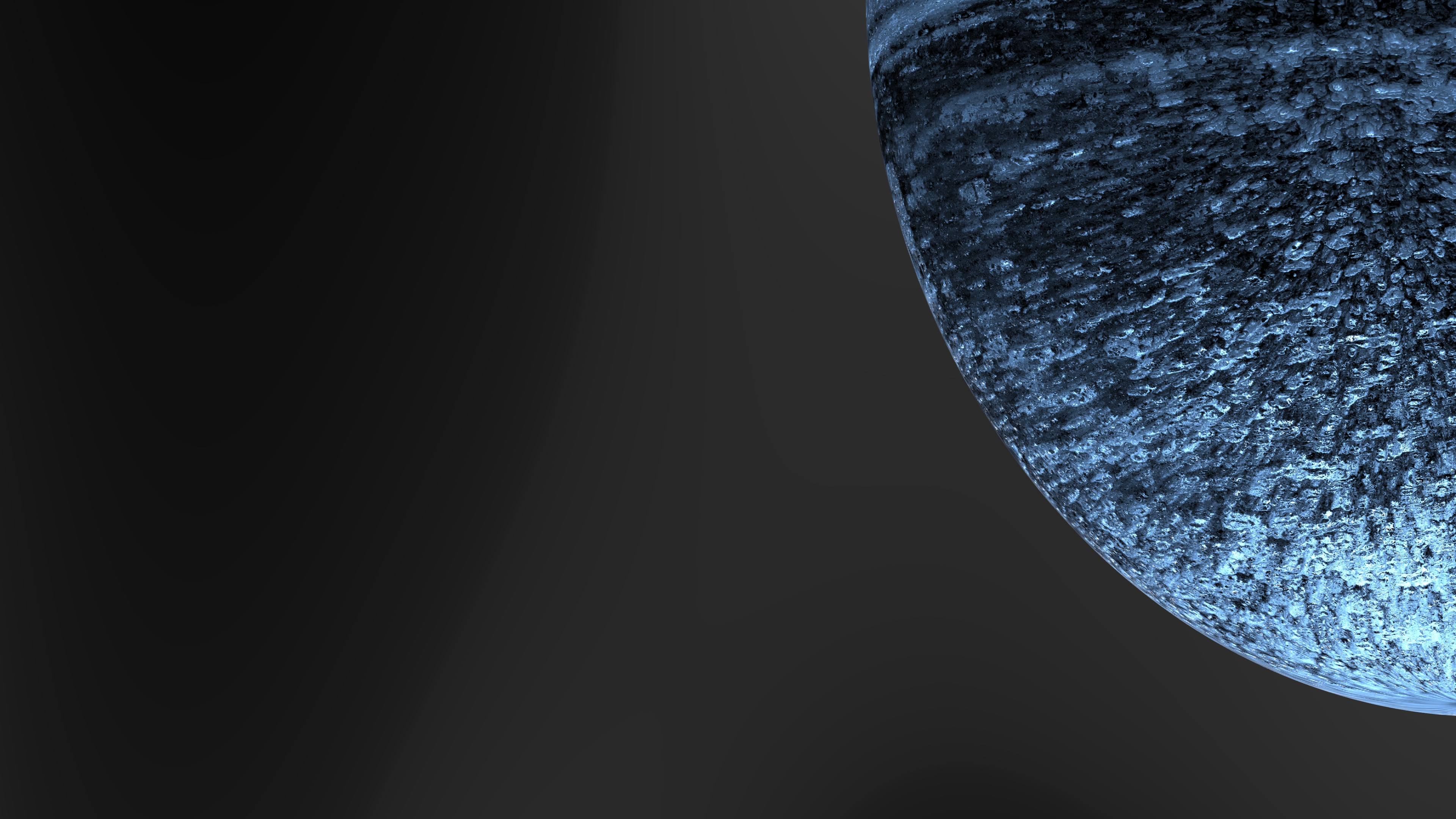
Image: video still Objects. Courtesy Tangere, 2021.
Unfamiliar Corners of the World
Curated by Wang Youxuan
20 April – 16 May 2021
The Learning Space is proud to present an exhibition by a young and emerging curator, Wang Youxaun (Anna).
Unfamiliar Corners of the World brings together three Australian-based artists who use the medium of video to explore the coexistence of humans and the natural world. Wang reflects that as environmental pollution has steadily become an urgent problem, the balance between nature and humans has become a focus of attention for many artists.
Throughout the exhibition we will be showing works from artists Hayden Fowler, Darryl Rogers, and Shoufay Derz.
Wang Youxuan (Anna) is a new curator based in Shanghai, China. She studied printmaking at the Brera Academy of Fine Arts in Milan which inspired her passion for contemporary art. Most recently she completed a Master of Curating and Cultural Leadership at UNSW Art and Design in Sydney. This exhibition is her first curatorial project after graduation. She is interested in using art as an intermediary between humanity and nature, focusing on current environmental issues while showing the unique thinking of artists.

Image credit: Video still of New World Order (2013) by Hayden Fowler
We would like to thank Artbank and Artereal Gallery for permission to screen these works.
Holobiont
Tully Arnot
3 – 11 February 2021
15 – 28 February 2021
The Learning Space is proud to show this unique work by Sydney artist, Tully Arnot.
Holobiont is an experimental documentary investigating human engagements with soil, clay and earth, presented alongside a live feed of protozoa and other soil microorganisms captured through a hobby microscope and Raspberry Pi camera.
The artwork presents a number of scientific and philosophical concepts in an accessible manner, and firmly situates itself in the realm of Citizen Science. It uses everyday microscopic technologies to investigate the world around us, specifically analysing local soil samples and encouraging a greater awareness of the symbiotic relationships we have with the local environment.
Tully Arnot's art practice explores the effect that contemporary technology has on human relationships and the natural world, using a variety of mediums such as kinetic sculpture, installation, video, photography and performance. His work examines the isolating effects of our increasingly connected, but ultimately disconnected world, exploring this through our (often simulated) engagement with the environment and other humans.

Libration Song
Chris Caines
10 February – 4 March 2020
Libration Song is a video piece based on our intimate and mostly unconscious relationship to the moon, the ocean, and its cycles. The videos in this artwork are synchronised to reflect the cycle of the high and low tides of the Rhodes shoreline.
Starting precisely at high tide at the beginning of the exhibition period, the videos slowly move in and out of phase as the moon shifts the tides, coming back into synchronisation at the end of the exhibition.
Chris Caines is an interdisciplinary artist who works with digital and electronic media including video, radio, music and sound. His artwork has been shown at festivals and museums including ACMI, The Queensland Art Gallery, Museum of Modern Art, New York, Tate UK, the Art Gallery of NSW and the Berlin, Venice and Cannes festivals. He is currently a Senior Lecturer in the Media Arts program at the University of Technology, Sydney.

Born on Saturn
Dr Wade Marynowsky
6 January – 2 February 2020
The Learning Space is proud to present a fantastic artwork by Sydney artist Dr Wade Marynowsky. Born on Saturn is a playful and personal work that invites the viewer to input their face, eyes, mouth, or any other object into the 3D generated artwork.
To create this work, a live camera input is fed into a computer and texture-mapped onto 3D spheres. The spheres are emitted from a particle system generator, a simulation of living systems that is used in computer graphics to create special effects such as bubbles, smoke, and fire.
Sound is also seen as a visual waveform in this 3D environment. The constant flow and spikes of the waveform may be interpreted to have new meaning, such as the rise and fall of polar ice caps or the cosmic mountains of an imaginary planet. Clap or yell to enjoy this part of the interactive artwork, and ponder how sound interconnects to the galaxy around us.
As the audience interacts with the camera, the behavioural parameters of the 3D system combine to create a strange doppelgänger effect. The audience multiplies on screen and flies around in this virtual environment, in turn becoming part of the computer-generated artwork.
Dr Wade Marynowsky is an artist, academic and researcher working across robotics, immersive and interactive performance and installation. His practice is characterised by large-scale robotic, sound, light and interactive works that combine humour, camp and a host of unnerving thematics to absorbing affect. Dr Marynowsky has exhibited nationally and internationally since 1998, with his work being presented in major festivals, biennales and survey exhibitions around the world. He is a lecturer in Interactive Design, School of Computer Science, Faculty of Engineering & IT, UTS.

Never Ending Time
Kellie O'Dempsey
4 November – 1 December 2019
The Learning Space is proud to present an exhibition by Brisbane artist Kellie O'Dempsey.
Never Ending Time brings together two of O'Dempsey's stunning video artworks The Never-ending Line and Negative Time Echo in a lyrical conversation about process and possibility. These works explore drawing as transformation through the use of traditional and digital drawing techniques.
These works are based around the action of drawing, with digital technology used to emphasise the gesture and performativity of the drawer. Investigating the idea that nothing is ever finished, these video works show the artist in an eternal loop of making and unmaking. The artist is seen drawing as lines that animate in a mesmerising continuum, as responsive exchange between line, sound and movement.
In exploring drawing through animation Never Ending Time encourages art-making as a playful and never-ending process.
Kellie O’Dempsey is a Brisbane-based artist who develops inclusive, site-specific installations and performances using drawing. Her work has been exhibited at the Museum of Old and New Art, the National Gallery of Australia and the Museum of Brisbane.

Home, Dignity, Justice: Images and Stories from the Australian Human Rights Commission
10 October – 3 November 2019
These powerful photographs are an intimate glimpse into the important work that human rights activists do around the world.
This photographic exhibition brings together entries by children and adults and aims to raise our awareness of human rights through the themes of home, dignity and justice.

Image: Stateless and Homeless: Displaced Rohingya Girl, IDP Camp, Sittwe, Myanmar, by Alister McKeich (2017).
Full Moon and the Bloom
Eye Shen
13 – 29 September 2019
Eye Shen’s mother photographs the flowers in her garden and sends them as daily digital greetings to family and friends overseas. These photographs embody nostalgia, the longing for reconnection and hope for a better life. Just like the colours of the flowers in these pictures, Australia embodies many diverse cultures and ethnicities. Migrants just like Eye Shen’s mother have profoundly influenced the places, people and community they live in.
In Full Moon and the Bloom the artist uses her mother's photographs to poetically portray the experience of immigration and displacement. Signifying day and night, these moving paintings represent the constant flux of our belonging and identity, morphing with personal and collective experiences. The work takes its title from a popular Chinese song from the 1940s, 月圆花好 (The Full Moon and the Blooming Flowers). The song depicts the concept of reunion and love, a topic that relates to many cultures.
Starting on the day of Mid-Autumn Festival, Eye Shen’s brightly coloured animation sends an auspicious message to everyone who walks past.
Eye Shen is a Sydney-based artist. Her work explores the question of individual and collective identities and belonging through digital footprints. Blending visual elements of her Chinese heritage with aesthetic and material experiments, her work is a dynamic story-telling of the world we live in.

Sea Rise in Canada Bay / What Lies Beneath
Andre Braun
26 August – 11 September 2019
What Lies Beneath explores the realities of waterway pollution – both physical and chemical – revealing an underwater landscape otherwise hidden from view. Sea Rise in Canada Bay reflects on how an increase in extreme weather patterns could dramatically change our shoreline – posing the question, how would Canada Bay look with a 2-3 metre sea rise?
These artworks have been created for The Digital Gallery using 3D visualisation to reflect on the impact of serious environmental issues affecting waterways around the world, including our very own Canada Bay.
Andre Braun is a Switzerland-born, Sydney-based artist working across sculpture, photography, graphics and visualisation.

Changing Landscapes: A History of Rhodes
5 – 18 August 2019
In this exhibition, we peer into the City of Canada Bay archives to find fascinating photos, maps, and illustrations that provide insight into the shifting landscape of Rhodes from 1850s up until the present day.
Rhodes Peninsular has undergone significant changes over the last two centuries. Prior to the arrival of the British in 1788, the Rhodes peninsula was part of the traditional lands of the Wangal Clan, one of 29 tribes of the Eora nation. The Wangal are believed to have inhabited the area for at least 15,000 years.
In 1886 the Northern Rail line between Strathfield and Hornsby was opened, with a railway station at Rhodes. This provided the impetus to develop industry along the rail line. Throughout much of the twentieth century, the landscape of Rhodes was dominated by industry. By the 1980s these industries began moving away from the peninsula, eventually making way for a vibrant residential area.
Thank you to our Local Studies Librarian for providing the images and information for this exhibition.
Art in Sequence
8 – 21 July 2019
Comic Con-versation is a week-long festival celebrating local comic creators in Libraries throughout Sydney. As part of this event The Learning Space is proud to present the exhibition Art in Sequence, featuring talented local comic artists. From fantasy adventures, crime thrillers, and witty commentaries on day-to-day life, these artists employ strikingly unique graphic styles that illustrate the scope and creative potential of storytelling through comics.
Featuring work by Han Nguyen, Andrew Tribe, Danielle Jadusingh, Harjanto Handinata, Julian Christopher Velasco, Nathan Seabolt, Queenie Chan, Robert Luxford, Delusional, Stephen Kok, and Victor Bravo.
All artists in this exhibition are members of The Sydney Comics Guild – a local community of comic creators who work together to support the creation of graphic novels, web comics, and zines throughout Sydney.

Image: The Perfect Storm of Crime by Andrew Tribe
Kylie Jenner-ated
Gen Collier
27 May – 16 June 2019
With Artificial Intelligence becoming increasingly part of our daily lives, multi-media artist Gen Collier is curious as to what its effects might mean for the future of our society and culture. Currently, AI, Machine Learning, and algorithms are already being applied all around us: YouTube and Spotify use AI to learn the behaviour of users, suggesting what we might like to listen to or purchase next. To what extent will these systems control what we do – or don’t – see, hear or experience? What is AI really capable of? How can it assist us? And how can we prepare for our future with it?
Kylie Jenner-ated is a computer generated artwork that examines contemporary processes of computation that are increasingly responsible for personal data collection. In this work, Collier uses AI as an artistic tool in attempt to make visible some of AI’s structures and processes. Kylie Jenner was chosen as the subject, as she is one of the most influential figures impacting contemporary notions of aesthetics and culture. After hundreds of images were collected the artist trained a type of Neural Network called a ‘GAN’ to learn what Jenner looks like, and then generate fake images within the dataset. Kylie Jenner-ated demonstrates the output of the system learning Collier’s aesthetics, and attempts to translate these processes in a way that that is easily observable to the viewer.
Gen Collier is a multimedia artist working at the intersection of digital media, experimental sound and music. Materials central to her practice include her laptop, data, code, software, programs and open-source libraries. She examines the effects of emerging technologies – particularly advances in the field of artificial intelligence and machine learning – on society and how they are beginning to shape culture and the way we experience information today.
.png)
While You Are Here... Digital Traces of Rhodes
2 January – 11 February 2019
This award winning artwork is a creative collaboration between The Learning Space and the Rhodes Multicultural Community Association (RMCA). In this project, Augmented Reality is used to capture how members of the local community have adopted the spaces around The Connection - transforming them into social and cultural landscapes where dance, music and song are exchanged.
While You Are Here…we invite you to experience these unique performances.
